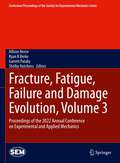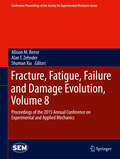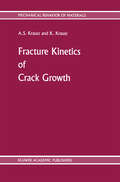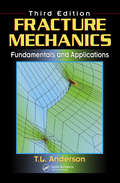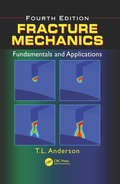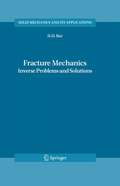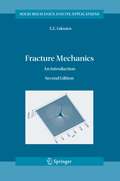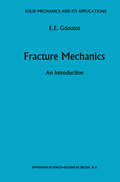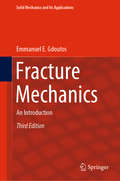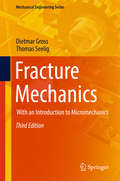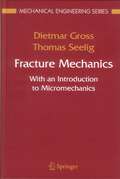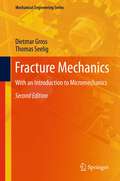- Table View
- List View
Fracture and Fatigue Emanating from Stress Concentrators
by G. PluvinageA vast majority of failures emanate from stress concentrators such as geometrical discontinuities. The role of stress concentration was first highlighted by Inglis (1912) who gives a stress concentration factor for an elliptical defect, and later by Neuber (1936). With the progress in computing, it is now possible to compute the real stress distribution at a notch tip. This distribution is not simple, but looks like pseudo-singularity as in principle the power dependence with distance remains. This distribution is governed by the notch stress intensity factor which is the basis of Notch Fracture Mechanics. Notch Fracture Mechanics is associated with the volumetric method which postulates that fracture requires a physical volume. Since fatigue also needs a physical process volume, Notch Fracture Mechanics can easily be extended to fatigue emanating from a stress concentration.
Fracture and Size Effect in Concrete and Other Quasibrittle Materials
by Zdenek P. Bazant Jaime PlanasFracture and Size Effect in Concrete and Other Quasibrittle Materials is the first in-depth text on the application of fracture mechanics to the analysis of failure in concrete structures. The book synthesizes a vast number of recent research results in the literature to provide a comprehensive treatment of the topic that does not give merely the facts - it provides true understanding. The many recent results on quasibrittle fracture and size effect, which were scattered throughout many periodicals, are compiled here in a single volume. This book presents a well-rounded discussion of the theory of size effect and scaling of failure loads in structures. The size effect, which is the most important practical manifestation of fracture behavior, has become a hot topic. It has gained prominence in current research on concrete and quasibrittle materials. The treatment of every subject in Fracture and Size Effect in Concrete and Other Quasibrittle Materials proceeds from simple to complex, from specialized to general, and is as concise as possible using the simplest level of mathematics necessary to treat the subject clearly and accurately. Whether you are an engineering student or a practicing engineer, this book provides you with a clear presentation, including full derivations and examples, from which you can gain real understanding of fracture and size effect in concrete and other quasibrittle materials.
Fracture and Size Effect in Concrete and Other Quasibrittle Materials
by Zdenek P. Bazant Jaime PlanasFracture and Size Effect in Concrete and Other Quasibrittle Materials is the first in-depth text on the application of fracture mechanics to the analysis of failure in concrete structures. The book synthesizes a vast number of recent research results in the literature to provide a comprehensive treatment of the topic that does not give merely the facts - it provides true understanding. The many recent results on quasibrittle fracture and size effect, which were scattered throughout many periodicals, are compiled here in a single volume. This book presents a well-rounded discussion of the theory of size effect and scaling of failure loads in structures. The size effect, which is the most important practical manifestation of fracture behavior, has become a hot topic. It has gained prominence in current research on concrete and quasibrittle materials. The treatment of every subject in Fracture and Size Effect in Concrete and Other Quasibrittle Materials proceeds from simple to complex, from specialized to general, and is as concise as possible using the simplest level of mathematics necessary to treat the subject clearly and accurately. Whether you are an engineering student or a practicing engineer, this book provides you with a clear presentation, including full derivations and examples, from which you can gain real understanding of fracture and size effect in concrete and other quasibrittle materials.
Fracture at all Scales: A Tribute To Stojan Sedmak (Lecture Notes in Mechanical Engineering)
by Guy Pluvinage Ljubica MilovicThis book is a compilation of selected papers from the 2014 New Trends in Fatigue and Fracture (NT2F14) Conference, which was held in Belgrade, Serbia. This prestigious conference brought together delegates from around the globe to discuss how to characterize, predict and analyze the fatigue and fracture of engineering materials, components, and structures using theoretical, experimental, numerical and practical approaches.It highlights some important new trends in fracture mechanics presented at the conference, such as:• two-parameter fracture mechanics, arising from the coupling of fracture toughness and stress constraints• high-performance steel for gas and oil transportation and production (pressure vessels and boilers)• safety and reliability of welded joints This book includes 12 contributions from well-known international scientists and a special tribute dedicated to the scientific contributions of Stojan Sedmark, who passed away in 2014.
Fracture Behavior of Asphalt Materials (Structural Integrity #14)
by Sadjad Pirmohammad Majid Reza AyatollahiThis book discusses the applications of fracture mechanics in the design and maintenance of asphalt concrete overlays. It provides useful information to help readers understand the effects of different material and loading type parameters on the fracture properties of asphalt concretes. It also reviews relevant numerical and experimental studies, and describes in detail design parameters such as aggregate type, air void, loading mode, and additives, based on the authors experience and that of other researchers.
Fracture Behavior of Nanocomposites and Reinforced Laminate Structures
by Ashwani Kumar Yogesh Kumar Singla Michael R. MaughanThis contributed volume is designed for fundamental understanding of fracture behavior of composites applied in core industrial sectors such as mechanical, electronics, Automotive, civil structures, and aerospace research and fills the gap of knowledge on fracture analysis. The book is primarily written for senior undergraduates, graduate students, and academic researchers in above mentioned fields.
Fracture Failure Analysis of Fiber Reinforced Polymer Matrix Composites (Engineering Materials)
by Sanjay Mavinkere Rangappa Thottyeapalayam Palanisamy Satishkumar Marta Maria Moure Cuadrado Suchart Siengchin Claudia BarileThis book presents a unified approach to fracture behavior of natural and synthetic fiber-reinforced polymer composites on the basis of fiber orientation, the addition of fillers, characterization, properties and applications. In addition, the book contains an extensive survey of recent improvements in the research and development of fracture analysis of FRP composites that are used to make higher fracture toughness composites in various applications.The FRP composites are an emerging area in polymer science with many structural applications. The rise in materials failure by fracture has forced scientists and researchers to develop new higher strength materials for obtaining higher fracture toughness. Therefore, further knowledge and insight into the different modes of fracture behavior of FRP composites are critical to expanding the range of their application.
Fracture, Fatigue, Failure and Damage Evolution, Volume 3: Proceedings of the 2022 Annual Conference on Experimental and Applied Mechanics (Conference Proceedings of the Society for Experimental Mechanics Series)
by Allison Beese Ryan B Berke Garrett Pataky Shelby HutchensFracture, Fatigue, Failure and Damage Evolution, Volume 3 of the Proceedings of the 2022 SEM Annual Conference & Exposition on Experimental and Applied Mechanics, the third volume of six from the Conference, brings together contributions to this important area of research and engineering. The collection presents early findings and case studies on a wide range of areas, including: Novel Experimental Methods Extreme Environments Interfacial Fracture Integration of Models & Experiments Mechanics of Energy & Energetic Materials Integration of Models & Experiments In Situ Techniques for Fatigue & Fracture Microscale & Microstructural Effects on Mechanical Behavior
Fracture, Fatigue, Failure and Damage Evolution , Volume 3: Proceedings of the 2020 Annual Conference on Experimental and Applied Mechanics (Conference Proceedings of the Society for Experimental Mechanics Series)
by Shuman Xia Allison Beese Ryan B. BerkeFracture, Fatigue, Failure and Damage Evolution, Volume 3 of the Proceedings of the 2020 SEM Annual Conference & Exposition on Experimental and Applied Mechanics, the third volume of seven from the Conference, brings together contributions to this important area of research and engineering. The collection presents early findings and case studies on a wide range of areas, including:Novel Experimental MethodsExtreme EnvironmentsInterfacial FractureIntegration of Models & ExperimentsMechanics of Energy & Energetic MaterialsIntegration of Models & ExperimentsIn Situ Techniques for Fatigue & FractureMicroscale & Microstructural Effects on Mechanical Behavior
Fracture, Fatigue, Failure, and Damage Evolution, Volume 5: Proceedings of the 2014 Annual Conference on Experimental and Applied Mechanics (Conference Proceedings of the Society for Experimental Mechanics Series)
by Jay Carroll Samantha DalyFracture, Fatigue, Failure and Damage Evolution, Volume 5: Proceedings of the 2014 Annual Conference on Experimental and Applied Mechanics, the fifth volume of eight from the Conference, brings together contributions to this important area of research and engineering. The collection presents early findings and case studies on a wide range of areas, including: Mixed Mode Fracture I: Emphasis on ModelingMixed Mode Fracture II: Emphasis on Experimental MeasurementsFull-Field Measurements of FractureMicroscale & Microstructural Effects on Mechanical Behavior I: Nanoscale EffectsMicroscale & Microstructural Effects on Mechanical Behavior II: MEMSMicroscale & Microstructural Effects on Mechanical Behavior III: MicrostructureMicroscale & Microstructural Effects on Mechanical Behavior IV: Shape Memory AlloysFracture & Fatigue of CompositesFracture & Fatigue for Engineering ApplicationsWave-Based Techniques in Fracture & Fatigue IWave-Based Techniques in Fracture & Fatigue II: Acoustic Emissions
Fracture, Fatigue, Failure and Damage Evolution, Volume 6: Proceedings of the 2018 Annual Conference on Experimental and Applied Mechanics (Conference Proceedings of the Society for Experimental Mechanics Series)
by Jay Carroll Shuman Xia Allison M. Beese Ryan B. Berke Garrett J. PatakyFracture, Fatigue, Failure and Damage Evolution, Volume 6 of the Proceedings of the 2018 SEM Annual Conference & Exposition on Experimental and Applied Mechanics, the sixth volume of eight from the Conference, brings together contributions to this important area of research and engineering. The collection presents early findings and case studies on a wide range of areas, including:Novel Experimental Methods Extreme Environments Interfacial Fracture Integration of Models & Experiments Mechanics of Energy & Energetic Materials Integration of Models & Experiments In Situ Techniques for Fatigue & Fracture Microscale & Microstructural Effects on Mechanical Behavior
Fracture, Fatigue, Failure and Damage Evolution, Volume 7: Proceedings of the 2017 Annual Conference on Experimental and Applied Mechanics (Conference Proceedings of the Society for Experimental Mechanics Series)
by Jay Carroll Shuman Xia Alison M. Beese Ryan B. Berke Garrett J PatakyFracture, Fatigue, Failure and Damage Evolution, Volume 7 of the Proceedings of the 2017 SEM Annual Conference & Exposition on Experimental and Applied Mechanics, the seventh volume of nine from the Conference, brings together contributions to this important area of research and engineering. Session organizers include: Jay Carroll, Shuman Xia, Allison Beese, Ryan Berke, Garrett Pataky, Samantha Daly, Kavan Hazeli, Antonios Kontsos, Omer Ozgur Capraz, Scott Grutzik, Onome Scott-Emaukpor The collection presents early findings and case studies on a wide range of areas, including: Mechanics of Energy & Energetic MaterialsVibration Effects in Fracture & FatigueFracture & Fatigue of Additively Manufactured MaterialsIn Situ Techniques for Fatigue & FractureMicroscale & Microstructural Effects on Mechanical BehaviorFracture & Fatigue of CompositesIntegration & Validation of Models with ExperimentsFracture & Fatigue in Extreme EnvironmentsNovel Experimental Methods for Fatigue and FractureFracture of Brittle & Ductile MaterialsInterfacial Fracture
Fracture, Fatigue, Failure and Damage Evolution, Volume 8: Proceedings of the 2015 Annual Conference on Experimental and Applied Mechanics (Conference Proceedings of the Society for Experimental Mechanics Series)
by Allison M. Beese Alan T. Zehnder Shuman XiaFracture, Fatigue, Failure and Damage Evolution, Volume 8 represents the eighth of nine volumes of technical papers presented at the Society for Experimental Mechanics (SEM) 15th International Congress & Exposition on Experimental and Applied Mechanics, held at Costa Mesa, California, June 8-11, 2015. The full set of proceedings also includes volumes on: Dynamic Behavior of Materials, Challenges in Mechanics of Time Dependent Materials, Advancement of Optical Methods in Experimental Mechanics, Experimental and Applied Mechanics, 16th International Symposium on MEMS and Nanotechnology, International Symposium on the Mechanics of Composite and Multi-functional Materials, 5th International Symposium on the Mechanics of Biological Systems and Materials, International Symposium on the Mechanics of Composite and Multi-functional Materials; and Residual Stress, Thermomechanics & Infrared Imaging, Hybrid Techniques and Inverse Problems.
Fracture, Fatigue, Failure and Damage Evolution, Volume 8: Proceedings of the 2016 Annual Conference on Experimental and Applied Mechanics (Conference Proceedings of the Society for Experimental Mechanics Series)
by Alan T. Zehnder Jay Carroll Kavan Hazeli Ryan B. Berke Garrett Pataky Matthew Cavalli Alison M. Beese Shuman XiaFracture, Fatigue, Failure and Damage Evolution, Volume 8 of the Proceedings of the 2016 SEM Annual Conference & Exposition on Experimental and Applied Mechanics, the eighth volume of ten from the Conference, brings together contributions to this important area of research and engineering. The collection presents early findings and case studies on a wide range of areas, including:In-situ Techniques for Fracture & FatigueGeneral Topics in Fracture & FatigueFracture & Fatigue of CompositesDamage, Fracture, Fatigue & DurabilityInterfacial Effects in Fracture & FatigueDamage Detection in Fracture & Fatigue
Fracture Kinetics of Crack Growth (Mechanical Behavior of Materials #1)
by A.S. KrauszOver the past few years, we have made numerous presentations, delivered several series of lectures, and participated in many discussions on the processes of time-dependent crack growth. We felt that the understanding of these processes had reached a degree of maturity: the basic physical principles were established and their application to engineering practice was now feasible. We concluded that the best way to organize this knowledge was to write it up in a single, coherent system. Martinus Nijhoff kindly encouraged us and generously offered their collaboration. Hence, this book. The physical process of time-dependent subcritical crack growth is rigorously defined by statistical mechanics. If well presented, the principles can be readily understood by practitioners of fracture research and design engineers. We present the physical processes of crack growth in terms of atomic interactions that assume only a working knowledge of the standard engineering materials course contents. From this, we develop a framework that is valid for any type of material, be it metallic, polymeric, ceramic, glass or mineral - indeed, any solid. We also assume an elementary exposure to fracture mechanics. An appendix is provided that outlines those aspects of fracture mechanics that are needed for an introduction to fracture kinetics analyses; it also provides a common ground for concepts and terminology (see Appendix A). We proceed through theory to applications that are of interest in research, development and design, as well as in test and operating engineering practice.
Fracture Mechanics: Fundamentals and Applications, Third Edition
by T. L. AndersonWith its combination of practicality, readability, and rigor that is characteristic of any truly authoritative reference and text, Fracture Mechanics: Fundamentals and Applications quickly established itself as the most comprehensive guide to fracture mechanics available. It has been adopted by more than 100 universities and embraced by thousands o
Fracture Mechanics: Fundamentals and Applications, Fourth Edition
by Ted L. AndersonFracture Mechanics: Fundamentals and Applications, Fourth Edition is the most useful and comprehensive guide to fracture mechanics available. It has been adopted by more than 150 universities worldwide and used by thousands of engineers and researchers. This new edition reflects the latest research, industry practices, applications, and computational analysis and modeling. It encompasses theory and applications, linear and nonlinear fracture mechanics, solid mechanics, and materials science with a unified, balanced, and in-depth approach. Numerous chapter problems have been added or revised, and additional resources are available for those teaching college courses or training sessions. Dr. Anderson’s own website can be accessed at www.FractureMechanics.com.
Fracture Mechanics: Inverse Problems and Solutions (Solid Mechanics and Its Applications #139)
by Huy Duong BuiThis book presents, in a unified manner, a variety of topics in Continuum and Fracture Mechanics: energy methods, conservation laws, mathematical methods to solve two-dimensional and three-dimensional crack problems. Moreover, a series of new subjects is presented in a straightforward manner, accessible to under-graduate students. Emphasizing physical or experimental back-grounds, then analysis and theoretical results, this monograph is intended for use by students and researchers in solid mechanics, mechanical engineering and applied mathematics.
Fracture Mechanics: An Introduction (Solid Mechanics and Its Applications #123)
by E.E. GdoutosNew developments in the applications of fracture mechanics to engineering problems have taken place in the last years. Composite materials have extensively been used in engineering problems. Quasi-brittle materials including concrete, cement pastes, rock, soil, etc. all benefit from these developments. Layered materials and especially thin film/substrate systems are becoming important in small volume systems used in micro and nanoelectromechancial systems (MEMS and NEMS). Nanostructured materials are being introduced in our every day life. In all these problems fracture mechanics plays a major role for the prediction of failure and safe design of materials and structures. These new challenges motivated the author to proceed with the second edition of the book. The second edition of the book contains four new chapters in addition to the ten chapters of the first edition. The fourteen chapters of the book cover the basic principles and traditional applications, as well as the latest developments of fracture mechanics as applied to problems of composite materials, thin films, nanoindentation and cementitious materials. Thus the book provides an introductory coverage of the traditional and contemporary applications of fracture mechanics in problems of utmost technological importance. With the addition of the four new chapters the book presents a comprehensive treatment of fracture mechanics. It includes the basic principles and traditional applications as well as the new frontiers of research of fracture mechanics during the last three decades in topics of contemporary importance, like composites, thin films, nanoindentation and cementitious materials. The book contains fifty example problems and more than two hundred unsolved problems. A "Solutions Manual" is available upon request for course instructors from the author.
Fracture Mechanics: An Introduction (Solid Mechanics and Its Applications #14)
by E.E. GdoutosNew developments in the applications of fracture mechanics to engineering problems have taken place in the last years. Composite materials have extensively been used in engineering problems. Quasi-brittle materials including concrete, cement pastes, rock, soil, etc. all benefit from these developments. Layered materials and especially thin film/substrate systems are becoming important in small volume systems used in micro and nanoelectromechancial systems (MEMS and NEMS). Nanostructured materials are being introduced in our every day life. In all these problems fracture mechanics plays a major role for the prediction of failure and safe design of materials and structures. These new challenges motivated the author to proceed with the second edition of the book. The second edition of the book contains four new chapters in addition to the ten chapters of the first edition. The fourteen chapters of the book cover the basic principles and traditional applications, as well as the latest developments of fracture mechanics as applied to problems of composite materials, thin films, nanoindentation and cementitious materials. Thus the book provides an introductory coverage of the traditional and contemporary applications of fracture mechanics in problems of utmost technological importance. With the addition of the four new chapters the book presents a comprehensive treatment of fracture mechanics. It includes the basic principles and traditional applications as well as the new frontiers of research of fracture mechanics during the last three decades in topics of contemporary importance, like composites, thin films, nanoindentation and cementitious materials. The book contains fifty example problems and more than two hundred unsolved problems. A "Solutions Manual" is available upon request for course instructors from the author.
Fracture Mechanics: An Introduction (Solid Mechanics and Its Applications #263)
by Emmanuel E. GdoutosThis book discusses the basic principles and traditional applications of fracture mechanics, as well as the cutting-edge research in the field over the last three decades in current topics like composites, thin films, nanoindentation, and cementitious materials.Experimental methods play a major role in the study of fracture mechanics problems and are used for the determination of the major fracture mechanics quantities such as stress intensity factors, crack tip opening displacements, strain energy release rates, crack paths, crack velocities in static and dynamic problems. These methods include electrical resistance strain gauges, photoelasticity, interferometry techniques, geometric and interferometry moiré, and the optical method of caustics.Furthermore, numerical methods are often used for the determination of fracture mechanics parameters. They include finite and boundary element methods, Green’s function and weight functions, boundary collocation, alternating methods, and integral transforms continuous dislocations.This third edition of the book covers the basic principles and traditional applications, as well as the latest developments of fracture mechanics. Featuring two new chapters and 30 more example problems, it presents a comprehensive overview of fracture mechanics, and includes numerous examples and unsolved problems. This book is suitable for teaching fracture mechanics courses at the undergraduate and graduate levels. A “solutions manual” is available for course instructors upon request.
Fracture Mechanics: With an Introduction to Micromechanics (Mechanical Engineering Series)
by Dietmar Gross Thomas Seelig- self-contained and well illustrated- complete and comprehensive derivation of mechanical/mathematical results with enphasis on issues of practical importance- combines classical subjects of fracture mechanics with modern topics such as microheterogeneous materials, piezoelectric materials, thin films, damage- mechanically and mathematically clear and complete derivations of results
Fracture Mechanics: With an Introduction to Micromechanics (Mechanical Engineering Series)
by Dietmar Gross Thomas Seelig- self-contained and well illustrated - complete and comprehensive derivation of mechanical/mathematical results with enphasis on issues of practical importance - combines classical subjects of fracture mechanics with modern topics such as microheterogeneous materials, piezoelectric materials, thin films, damage - mechanically and mathematically clear and complete derivations of results
Fracture Mechanics: With an Introduction to Micromechanics (Mechanical Engineering Series)
by Dietmar Gross Thomas Seelig- self-contained and well illustrated- complete and comprehensive derivation of mechanical/mathematical results with enphasis on issues of practical importance- combines classical subjects of fracture mechanics with modern topics such as microheterogeneous materials, piezoelectric materials, thin films, damage- mechanically and mathematically clear and complete derivations of results







